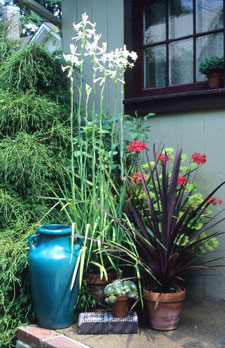Luxuriously Fragrant Aztec Tuberoses
“Everyone who has a garden, or a taste for flowers, knows the tuberose,” C.L. Allen wrote in 1893, and that had been true in America since colonial times. But today, these luxuriously fragrant bulbs are woefully uncommon. To help gardeners rediscover the timeless pleasures of tuberoses, Old House Gardens has named the easy-to-grow ‘Mexican Single’ variety their 2004 Heirloom Bulb of the Year for spring planting. Says Old House Gardens’ owner Scott Kunst,“ It’s an antique flower so exciting we think it belongs in every garden.”
Despite its long history, Polianthes tuberosa has never been found in the wild and is believed to be extinct there — all the more reason to grow it in your own backyard. It was domesticated by the Aztecs who held it sacred to Xochiquetzal, “the Aztec Aphrodite,” goddess of the earth, flowers, music, dance, beauty, and especially love. It was brought to Europe by 1530, and Parkinson included it in his great florilegium of 1629, calling it the “Indian knobbed Iacinth.” By 1730 it was thriving in Williamsburg, and in 1777 pioneering American botanist William Bartram reported it on a plantation near Baton Rouge where the flower stalks were a prodigious “five to seven feet high in the open ground, the flowers being very large and abundant.”
More typically tuberoses bloom on stalks three to four feet high over a clump of grassy foliage. Though the starry white flowers of ‘Mexican Single’ have a simple, old-fashioned beauty, it’s their ravishing fragrance that makes gardeners swoon. Some compare it to vanilla, others to orange blossoms, gardenias, or even buttered popcorn. And it’s richer in the evening, making it perfect for gardeners who are at work during the day. Millions of pounds of tuberose blossoms are harvested annually in Provence for the perfume trade, and all are picked at night.

here on our back stoop.
Though they’re subtropical plants, tuberoses are not just for the South, Kunst says, noting that Old House Gardens’ bulbs come from a family farm in Illinois where they’ve been grown commercially since the 1930s. “They’re easy to grow almost anywhere as long as you start with big bulbs, about the size of a hefty thumb, and then give them the three things C.L. Allen recommended for them in 1893: ‘heat, water, and manure’ — or any garden fertilizer.” In the North, where soils warm slowly, they bloom best in pots. That also makes it easy to move them right where you want to enjoy them when they start to bloom.
Tuberoses are easy, fragrant, deeply historic, and you won’t see them in everyone else’s yard. Plant a few this spring and you’ll soon discover for yourself why so many gardeners through the centuries have loved them.












